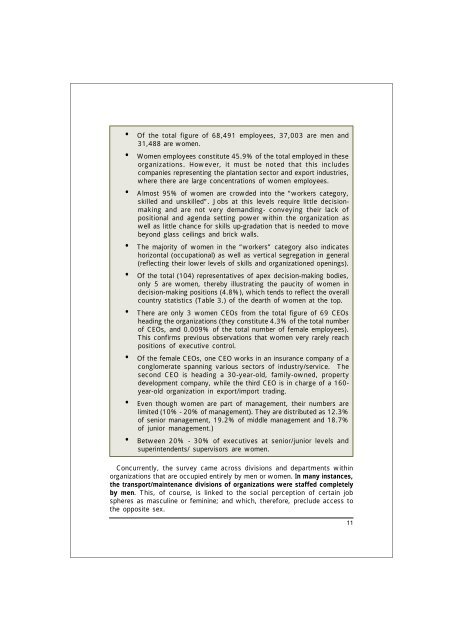Beyond Glass Ceilings and Brick Walls - International Labour ...
Beyond Glass Ceilings and Brick Walls - International Labour ...
Beyond Glass Ceilings and Brick Walls - International Labour ...
You also want an ePaper? Increase the reach of your titles
YUMPU automatically turns print PDFs into web optimized ePapers that Google loves.
• Of the total figure of 68,491 employees, 37,003 are men <strong>and</strong><br />
31,488 are women.<br />
• Women employees constitute 45.9% of the total employed in these<br />
organizations. However, it must be noted that this includes<br />
companies representing the plantation sector <strong>and</strong> export industries,<br />
where there are large concentrations of women employees.<br />
• Almost 95% of women are crowded into the “workers category,<br />
skilled <strong>and</strong> unskilled”. Jobs at this levels require little decisionmaking<br />
<strong>and</strong> are not very dem<strong>and</strong>ing- conveying their lack of<br />
positional <strong>and</strong> agenda setting power within the organization as<br />
well as little chance for skills up-gradation that is needed to move<br />
beyond glass ceilings <strong>and</strong> brick walls.<br />
• The majority of women in the “workers” category also indicates<br />
horizontal (occupational) as well as vertical segregation in general<br />
(reflecting their lower levels of skills <strong>and</strong> organizationed openings).<br />
• Of the total (104) representatives of apex decision-making bodies,<br />
only 5 are women, thereby illustrating the paucity of women in<br />
decision-making positions (4.8%), which tends to reflect the overall<br />
country statistics (Table 3.) of the dearth of women at the top.<br />
• There are only 3 women CEOs from the total figure of 69 CEOs<br />
heading the organizations (they constitute 4.3% of the total number<br />
of CEOs, <strong>and</strong> 0.009% of the total number of female employees).<br />
This confirms previous observations that women very rarely reach<br />
positions of executive control.<br />
• Of the female CEOs, one CEO works in an insurance company of a<br />
conglomerate spanning various sectors of industry/service. The<br />
second CEO is heading a 30-year-old, family-owned, property<br />
development company, while the third CEO is in charge of a 160-<br />
year-old organization in export/import trading.<br />
• Even though women are part of management, their numbers are<br />
limited (10% - 20% of management). They are distributed as 12.3%<br />
of senior management, 19.2% of middle management <strong>and</strong> 18.7%<br />
of junior management.)<br />
• Between 20% - 30% of executives at senior/junior levels <strong>and</strong><br />
superintendents/ supervisors are women.<br />
Concurrently, the survey came across divisions <strong>and</strong> departments within<br />
organizations that are occupied entirely by men or women. In many instances,<br />
the transport/maintenance divisions of organizations were staffed completely<br />
by men. This, of course, is linked to the social perception of certain job<br />
spheres as masculine or feminine; <strong>and</strong> which, therefore, preclude access to<br />
the opposite sex.<br />
11
















